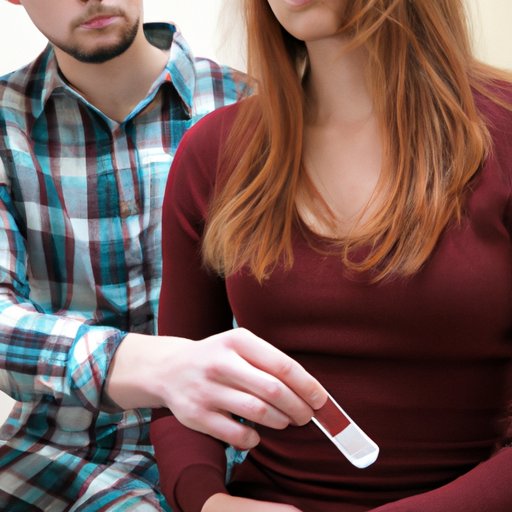
Introduction: The Importance of Understanding Chlamydia Symptoms
When it comes to sexually transmitted infections (STIs), chlamydia is one of the most common. It affects both men and women and can cause serious health problems if left untreated. Unfortunately, many people who have chlamydia may not know it because they don’t experience any symptoms. This is why understanding how long for chlamydia symptoms to show up is crucial.
The Silent STI: How Long Can You Have Chlamydia Without Symptoms?
Chlamydia is a bacterial infection that can be transmitted through vaginal, anal, or oral sex. It is caused by the bacterium Chlamydia trachomatis and can infect the urethra, cervix, rectum, throat, and eyes. While some people with chlamydia may experience symptoms such as discharge from the penis or vagina, pain or burning during urination, or pain during sex, many others may not have any symptoms at all.
Asymptomatic chlamydia is a concern because it can lead to serious health problems if left untreated. According to the Centers for Disease Control and Prevention (CDC), up to 70% of women and 50% of men with chlamydia may not have any symptoms. This can make it difficult to know when to seek medical attention and get tested.
The prevalence of asymptomatic chlamydia is particularly high among young people aged 15-24. This age group accounts for nearly two-thirds of all reported cases of chlamydia in the United States. This is why it’s important for young people to get tested regularly, even if they don’t have any symptoms.
Risk factors for asymptomatic chlamydia include having multiple sexual partners, having unprotected sex, and having a history of STIs. It’s important to get tested regularly if you have any of these risk factors or if you think you may have been exposed to chlamydia.
When Will Chlamydia Symptoms Show Up?
The timeline for chlamydia symptoms to appear after infection can vary, but most people who develop symptoms will do so within 1-3 weeks of being infected. However, it’s possible for symptoms to appear sooner or later than this.
In some cases, people may not experience any symptoms for several months or even years after being infected with chlamydia. This can make it difficult to know when they became infected and can also increase the risk of developing serious health problems as a result of untreated chlamydia.
Chlamydia symptoms can vary from person to person, and some people may only experience mild symptoms or no symptoms at all. Common symptoms of chlamydia in women include abnormal vaginal discharge, burning during urination, and pain during sex. Men with chlamydia may experience discharge from the penis, pain during urination, and swollen or tender testicles. Both men and women may experience rectal pain, discharge, or bleeding if they have anal chlamydia.
It’s important to watch for warning signs of chlamydia, such as unusual discharge, pain, or discomfort in the genital or anal area. If you experience any of these symptoms, it’s important to seek medical attention right away.
Chlamydia Symptom Checker: Signs to Look Out For
If you’re concerned that you may have chlamydia, there are several symptoms to watch for. In women, the most common symptoms include:
- Abnormal vaginal discharge
- Burning during urination
- Pain during sex
- Rectal pain, discharge, or bleeding (with anal chlamydia)
In men, the most common symptoms of chlamydia include:
- Discharge from the penis
- Pain or burning during urination
- Swollen or tender testicles
- Rectal pain, discharge, or bleeding (with anal chlamydia)
It’s important to seek medical attention if you experience any of these symptoms, as chlamydia can cause serious health problems if left untreated. Self-diagnosing can be dangerous, so it’s important to see a healthcare provider for proper testing and treatment.
Living with Chlamydia: Coping with Long-Term Symptoms
Untreated chlamydia can lead to serious health problems such as pelvic inflammatory disease (PID), which can cause infertility in women. It can also cause chronic pelvic pain, arthritis, and other long-term health issues in both men and women.
Some individuals with chlamydia may experience long-term symptoms even after receiving treatment. These symptoms can include chronic pelvic pain, fatigue, and pain during sex. There is no cure for these symptoms, but they can be managed with medication and lifestyle changes.
If you’re experiencing long-term symptoms after receiving treatment for chlamydia, it’s important to talk to your healthcare provider about your options. They may be able to recommend treatments that can help manage your symptoms and improve your quality of life.
Preventing Chlamydia: How Long After Exposure Should You Get Tested?
There are several steps you can take to reduce your risk of contracting chlamydia. These include:
- Using condoms or dental dams during sex
- Limiting your number of sexual partners
- Getting tested regularly for STIs, including chlamydia
Chlamydia testing is generally done through a urine or swab test. It’s important to wait at least 7-10 days after exposure to chlamydia before getting tested, as it can take some time for the infection to be detectable.
Early diagnosis and treatment are crucial for preventing serious health problems related to chlamydia. If you suspect you may have been exposed to chlamydia, it’s important to get tested as soon as possible.
Conclusion: Encouraging Readers to Take Action
Understanding how long for chlamydia symptoms to show up is crucial for protecting your health and preventing the spread of STIs. If you’re sexually active, it’s important to practice safe sex and get tested regularly for STIs, including chlamydia.
Remember to watch for warning signs of chlamydia and seek medical attention right away if you experience any symptoms. Early diagnosis and treatment can prevent serious health problems and improve your quality of life.
By taking action to prevent and manage chlamydia, you can protect your health and ensure a happy, healthy future.





